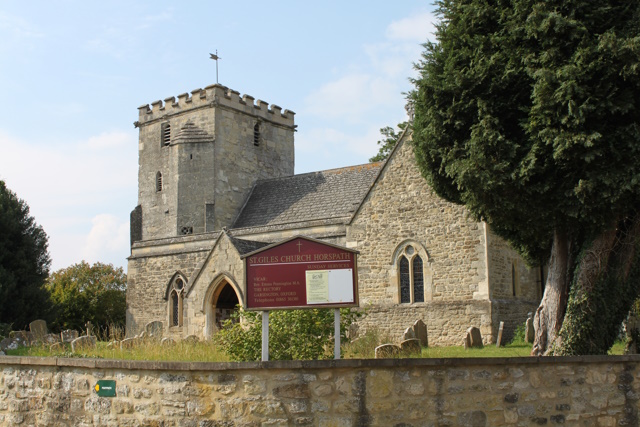


























St Giles Church, Horspath
St. Giles Church in Horspath is a stone building consisting of nave, chancel, south aisle, north and south transepts or chapels, west tower, and south porch, and stands in the northern part of the village in a large churchyard. The nave was probably built in the late 12th century, as were the four slightly pointed massive arches separating it from the south aisle. The south transept was added in the late 13th century; the piscina in the south wall of the latter shows that it was originally a chantry. The embattled tower, with a west doorway and a three-light west window, was probably added about 1400. The high arch between nave and tower, which is perhaps the best feature of the church, was also built about 1400; on its corbels are two stone figures, the one to the right playing a bagpipe. There are various traditions about them; one, repeated by Hearne, was that the man was Thomas London, a bagpiper, who built the church. The south porch was probably added in the 14th century, and in the 15th the original pitch of the roof was lowered; new windows of late-15th-century style were also inserted in the side walls of the chancel and the north wall of the nave. These are similar to some in Magdalen College (c. 1480). In the 18th century an unusually high gallery, to the cost of which Magdalen College and the Earl of Abingdon contributed, was added. It concealed the arch between tower and nave, and was 'adorned with a profusion of paint and gilded smirking cherubs'. In 1840, as the east wall of the chancel was out of alignment, the whole chancel was pulled down and the present one, in the Perpendicular style, built. The original chancel had 'Early English' walls, a medieval roof, and three lancet windows at the east end. The latter were replaced by an imitation Perpendicular east window, but the 15th-century side windows were reinserted, and the glass and unusual 'Early English' cross preserved. The architect responsible for this 'wanton and useless destruction' was probably H. J. Underwood. In 1849 the church was in a 'very dilapidated and dangerous state', and plans were drawn up by Underwood for another restoration. The work was to cost £800, of which Magdalen gave £200 and Baker Morrell the same, and was carried out in 1852. The north transept was added, the north wall of the nave rebuilt, and nave and south transept reroofed, the gallery taken down, and the clerestory of uncertain date, 'little more than a skylight', removed. There is some good medieval stained glass: in the north-east window of the chancel a 15th-century Crucifixion and a later representation of Adam and Eve, and in the north-west and south-west windows coats of arms, including those of Magdalen College; in the east window of the south transept a 15thcentury mitred figure of unknown identity. The south-east window of the chancel has some fragments of richly coloured early figure glass and the southwest window some 16th-century continental glass. In 1740 the President of Magdalen gave, at a cost of £30, the window in the north aisle commemorating the Copcot legend. The maker is said to have been Price of York. The hexagonal font is probably contemporary with the earliest parts of the church; it was originally circular. By the south door is what seems to be a 12th-century stoup, the origin and purpose of which has been much debated. The fine carved pulpit is Jacobean and the gift of Magdalen College. On the floor of the nave is the matrix of a large brass with a pastoral staff, which may be the tomb of an Abbot of Oseney. It once had the inscription: 'Hic situs abbatis . . . patet esse Johannis.' There are some 17th- and 18th-century monuments to the Herbert family, including one to Esther Herbert— 'the truest overseer of the poor, The constant visitor of the sick man's door'—(d. 1688/9), and others to James Salisbury of Bullingdon Green (d. 1770) with his arms; to Richard Green, printer of Oxford (d. 1750); one to Elizabeth Spencer (d. 1727) and to Edward (d. 1744) and William Ford (d. 1744). There is a good silver chalice, probably of 1569, but no paten cover; a frail silver paten of unknown date; and a 19th-century paten and two cruets. Two chalices and six vestments were recorded in the earlier Edwardian inventory, which must have included the one given by Magdalen College about 1480. The clock is old and there are five mass dials. In 1553 there were three bells and a little one; in 1554 only three; and in the 18th century five. Though very small, they were considered 'the prettiest tunablest bells in England' with hardly a fault. Of the six bells and sanctus now existing, the earliest dates from 1602. The registers date from 1561 but entries before 1600 are copied from an earlier register. The churchwardens' accounts are dated 1708–9 and 1830–48. Historical information about St. Giles Church is provided by 'Parishes: Horspath', in A History of the County of Oxford: Volume 5, Bullingdon Hundred, ed. Mary D Lobel (London, 1957), pp. 177-189. British History Online http://www.british-history.ac.uk/vch/oxon/vol5/pp177-189 [accessed 20 March 2023]. St. Giles Church is a Grade II* listed building. For more information about the listing see CHURCH OF ST GILES, Horspath - 1047462 | Historic England. For more information about St. Giles Church see Parishes: Horspath | British History Online (british-history.ac.uk). |

